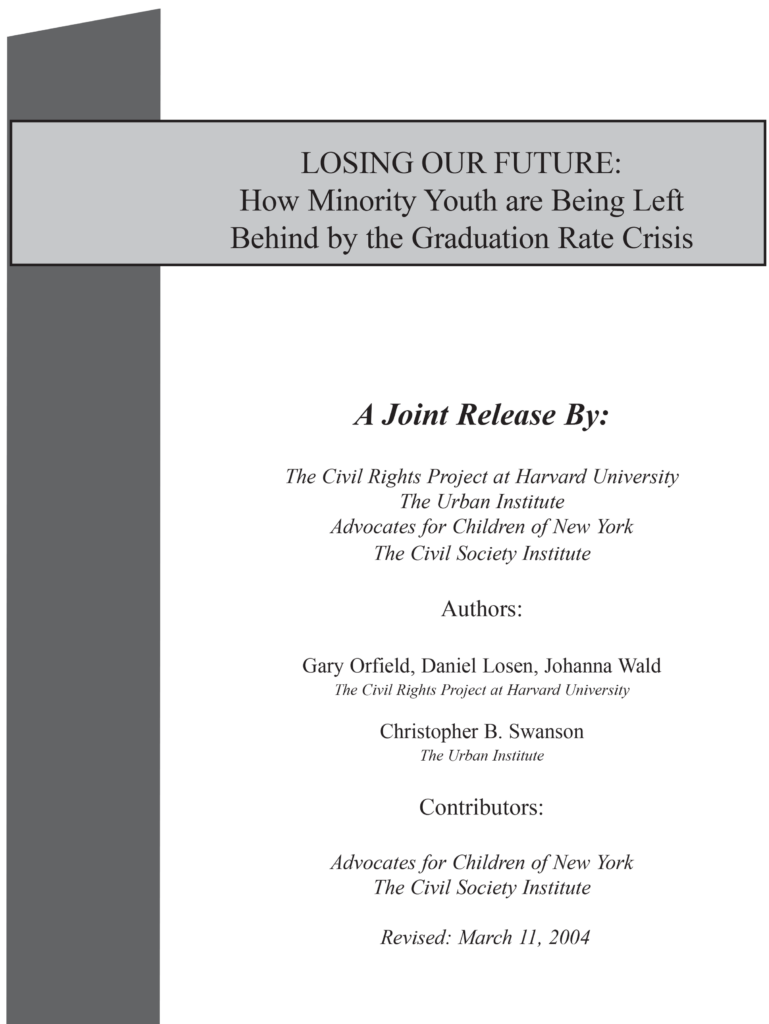Losing Our Future: How Minority Youth are Being Left Behind by the Graduation Rate Crisis
By Gary Orfield , Daniel Losen, Johanna Wald and Christopher B. Swanson
Every year, across the country, a dangerously high percentage of students—disproportionately poor and minority—disappear from the educational pipeline before graduating from high school. Nationally, only about 68 percent of all students who enter 9th grade will graduate “on time” with regular diplomas in 12th grade. While the graduation rate for white students is 75 percent, only approximately half of Black, Hispanic , and Native American students earn regular diplomas alongside their classmates. Graduation rates are even lower for minority males. Yet, because of misleading and inaccurate reporting of dropout and graduation rates, the public remains largely unaware of this educational and civil rights crisis.
Recently, Congress took a first step in recognizing the severity of the dropout problem by including graduation rate accountability provisions in the No Child Left Behind Act (NCLB), enacted in 2002. Unfortunately, the Department of Education has issued regulations that allow schools, districts, and states to all but eliminate graduation rate accountability for minority subgroups. By doing so, Department officials have rendered these accountability measures virtually meaningless..
The implications for individuals, communities, and the economic vitality of this country are far-reaching and devastating. High school dropouts are far more likely to be unemployed, in prison, and living in poverty. Many studies estimate significant losses in earnings and taxes with economic and societal effects that last generations.
Report Purpose and Methodology
Our goal in issuing this report is to raise public awareness of the issue, and to make improving high school graduation rates a more central component of national educational reform efforts. We believe that the first step must entail highlighting the severe racial disparities in high school graduation rates that exist at the school and district levels.
Because that goal has been impeded in the past by grossly inaccurate and misleading official dropout data, this report spells out in some detail how we arrived at our figures, and why we assert that the methods we used provide far more accurate information than is currently officially reported by both the federal government and by most states. This analysis draws on the expertise of Dr. Christopher Swanson of the non-partisan The Urban Institute, one of the nation’s leading experts on enrollment and graduation rate data. As co-author, Dr. Swanson calculated the graduation rates employed throughout the report using the “Cumulative Promotion Index” (CPI). CPI is a method he independently developed and tested to provide more accurate graduation rate estimates.
The report combines findings of a comprehensive review of graduation rate accountability derived from each state’s website, along with interviews of state education officials. Finally, the report provides recommendations on how both the federal government and individual states can act to address this crisis.
Woven throughout this report are narratives about students who have either dropped out or felt “pushed” out of school, often due to the pressure experienced by officials to raise their schools’ overall test profiles. Collectively, these stories highlight the critical need to provide individual schools and school districts with positive incentives to hold onto more students through graduation.
In compliance with the UC Open Access Policy, this report has been made available on eScholarship:
